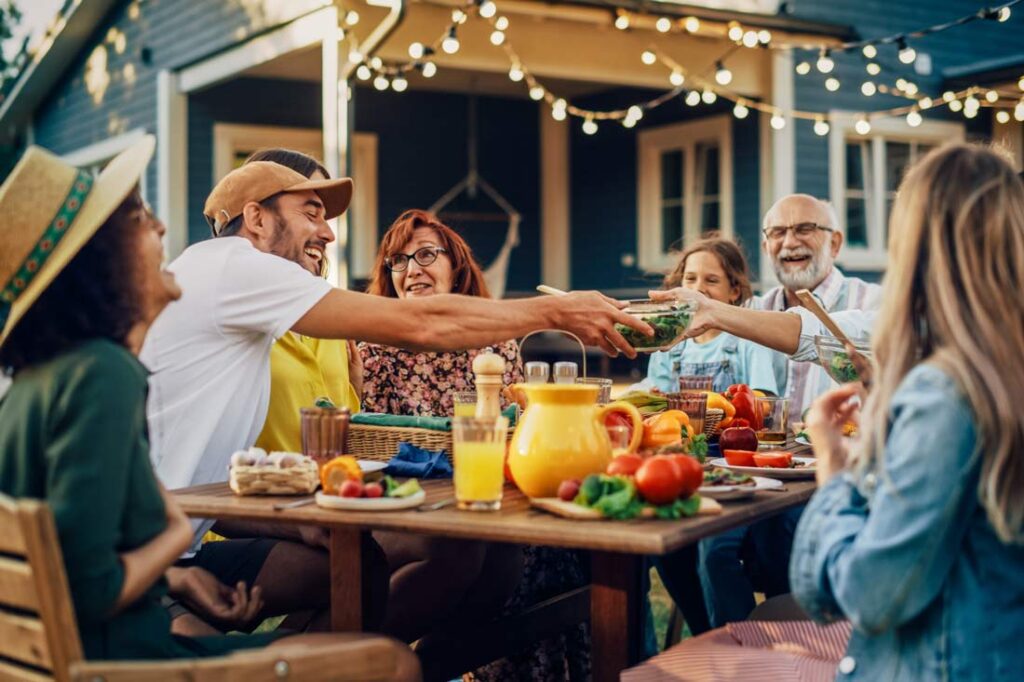We’ve heard the advice so much our whole lives that we can recite it in our sleep: Eat nutritious foods, move our bodies, don’t stress. Yet, Americans are facing the shortest life expectancy in the past two decades, according to December 2022 CDC data. In fact, most of us can expect to live just 76.4 short years. But this isn’t the case everywhere, and in a Netflix docuseries featuring bestselling author Dan Buettner, viewers take a trip around the world to peek inside the communities with the most 100-year-olds, called Blue Zones.
Buettner, a National Geographic Fellow and three-time Guinness World Record Distance Cycle Holder, examines diet, exercise, community and many other aspects of life beyond the basic advice we’ve always heard for longevity. He visited Okinawa, Japan; Ikaria, Greece; Sardinia, Italy; Nicoya, Costa Rica; and Loma Linda, California, interviewing people in the Blue Zones about their lives. His answers have people talking about both the systems we live in that don’t support longevity, and how to support and rebuild the ones that do, or could. Through visits to places full of centenarians (people who make it to 100 and beyond), viewers learn 12 lessons that make up the secret sauce to living not only a long life, but a healthy and fulfilling one.
Contextualizing Netflix’s ‘Live to 100’ for modern times
Darnell Cox is a healthy aging expert, gerontologist and lifestyle coach with a popular YouTube channel and blog through her business Live Young Lifestyle. She points out that although the documentary is exceptionally helpful in framing what we need to do to live a long life, we also have to contextualize the era we are living in, versus the ones current centenarians saw in their youth and middle age.
She points to differences in health care, medicine, transportation and communication over the decades, for better or worse. “There’s no denying that life is better for me in my middle age than it was for the current 100-year-olds. But there are some things that are worse. The world is more polluted in our air and water, plastics and other toxic substances abound, food—whether it’s from animals or a vegetarian menu—is increasingly inorganic,” she says. “And it’s difficult for any of us to hide from these changes, even those in the Blue Zones.”
She also points to technology as making a profound difference in our lives, impacting our relationships that have long been proven to impact longevity. “We text, email and message instead of talking on the phone. We don’t see each other, hear each other, hug each other as often as we should. We have lost opportunities for meaningful engagement, for volunteering, mentoring and sharing wisdom. Our connection is virtual, our communities are virtual and, with that, we have lost one of the keys to living happier and living longer.”
Cox tries to embody some of the behaviors from the Blue Zones, but she realizes it might involve some changes that feel like revisiting “old times”—from putting away our iPhones to hugging more, even if it’s just a bit each day.
Want to live to 100? Try these lifestyle tips
Revamping your lifestyle choices is no quick fix, but the potential prize is worth the effort. Here are a few tips that Buettner concluded are on the must-try list for people across the world seeking the ultimate bragging rights in the game of life—100 years on Earth.
Move it, move it!
You don’t have to join a boutique gym at $200 per month (or way, way more!) to achieve this goal. In fact, the CDC suggests prioritizing 150 minutes a week, including two days of muscle strengthening for optimal health. It can happen anywhere from living rooms and neighborhood sidewalks to farms that require physical movement. Buettner chats with people who are accomplishing those activities daily and spending little time sitting at desks. Many of the communities he features have gardens, do their own cooking with fresh ingredients (which is physical at times) and don’t really use cars to get around. Sounds great, an American reading this from a suburb might think, except in many places we don’t have that setup.
Orthopedic spine surgeon Dr. Carl Giordano, chief science officer and cofounder of Rebesana, has studied longevity and genetic aspects of aging and cancer at NIH and Rockefeller University. He says the documentary was “beautifully done,” and he’s happy to see 50 years of known research getting resurfaced in such an approachable way. “I recognize that we live in a different world, and some things done in the Netflix series are not easily done in this country,” he says. But the series did make it very clear that activity and exercise are a must.
“Regarding exercise, I don’t think there’s anywhere in America where you cannot participate in strength training, aerobic conditioning, stretching and balance exercises,” he says, insisting that carving out movement time for 45 minutes a day is a must for everybody.
Connect to a greater purpose
God. The universe. Legacy. Ancestors. Life mission. Whatever you call it, you need it, Buettner concludes in his research. He highlights the Japanese concept “ikigai,” which means life, and benefit or worth. Combined, the word means finding your purpose, or reason for being alive. Some in the docuseries are devout Catholics, and still others find their purpose in loving and supporting those around them, including the next generations.
In one anecdote, women in the village rally around an elderly woman without family, taking turns caring for her so she isn’t put in a retirement home. “They create opportunities for meaningful engagement and contribution, such as volunteering, mentoring and sharing wisdom. They enhance happiness and satisfaction with life, which can boost immunity and longevity,” Cox says.
In Loma Linda, the only U.S. Blue Zone, centenarians are of the Adventist faith, and spend Saturday, their Sabbath, strictly relaxing. One woman attends choir practice just before that time, and relaxes through music and the connection it brings to her faith.
The power of plants
From food to medicine, each centenarian had an important connection to the earth in some form. Greek women were grinding herbs in their Blue Zone to make tea with fresh honey that wasn’t processed like the ones in our grocery stores. Plants were used as medicine in a variety of ways.
“Today’s 100-year-olds were born in 1923, and they’ve seen undeniable advances in medicine, infrastructure, technology and communication. Before they turned 50, they had lived through two world wars. They’d seen the invention of penicillin, dialysis machines and the iron lung. They were the first to enjoy drive-in movies, color films, car radios and televisions,” Cox says. “They saw the first helicopters, rockets and jet engines. They watched a man walk on the moon. All before they turned 50.”
Plants are large parts of centenarian diets as well, with up to 95% of their foods coming from a diverse spread of beans, legumes, plants and limited meat. An accessible diet combining squash, beans and corn—featured in Nicoya as the secret to health—is dubbed the “three sisters.” But throughout the series, you can sense Buettner’s discouragement as he sees Pizza Huts and convenience stores popping up in traditionally ultra-healthy zones.
In addition to plants, nuts are widely regarded as must-haves for chronic disease prevention, and keeping toxic substances like alcohol in check was a widespread common thread in the Blue Zones, though many didn’t abstain completely from alcohol. There was little carb-limiting or fad dieting, but instead a focus on plant nutrition and moderation.
How to live to 100: Connections matter
Buettner points to research that shows just how deep our social connections are related to our health. For example, Sardinia doesn’t really have nursing homes, and in each location, groups of friends or family are integral to daily life.
In addition, unwinding and resting with these people, from Greek families drinking and dancing in the evening sunset to hardworking farmers hanging out at the local pub with friends, are all must-have facets of finding true rest. It’s a mission Westerners have been on since the invention of hustle culture. But this mission appears more attainable now as people seek to find more work-life balance post-pandemic, when burnout was rampant.
Centenarians love deeply. They prioritize romantic relationships and have higher rates of marriage. “Some of the examples of how connection and community are practiced in the Blue Zones: In Okinawa, Japan, a lifelong group of friends (moai) provides financial emotional support. In Sardinia, Italy, people value family and intergenerational relationships and choose to live near their relatives,” Cox observed.
To prioritize love and connection in a technological society, Cox has some tips:
- Switch some of those virtual meetings to in-person
- Put aside devices when we can, to practice meaningful listening
- Volunteer or mentor someone
- Hug often
- Spend more time with our children
- Check your social media use, and its connection to your stress
“Our current centenarians didn’t feel the need to photograph their plate of sea bass and asparagus so that they might virtually share it with their friends,” Cox says. “They didn’t have to compare their lifestyle, their limos and their looks with heavily filtered fantasies that present as reality, creating a sense of competition or even self-loathing.” Instead, they lavished their undivided attention on those who were right in front of them, and spent time together, listening and sharing. Building connections matters. Our longevity, and our influence on the next generation, depends on it.
Photo by Gorodenkoff/Shutterstock.com



